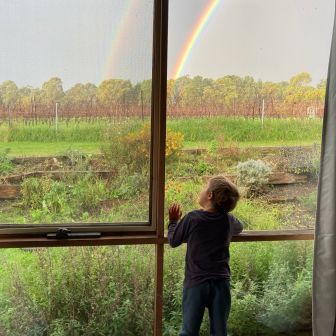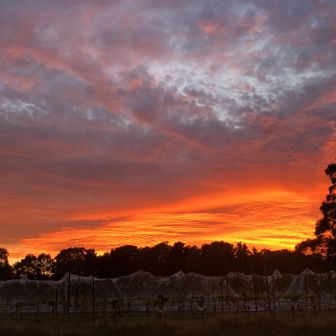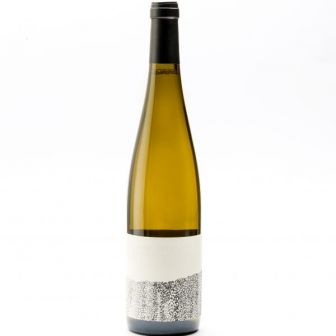In the thick of it
November 18, 2018
Dear friends
Spring sprang, the grass ris, the weeds shrugged off their winter slumber and launched for the sky… and the bloody tractor broke. Well, we call it a tractor for the sake of our little boys who like to take turns donning their earmuffs and ‘helping Daddy do farming’ but really it’s just a big ride-on mower.
At this time of year when the vines have bounced back to life and started pulling minerals, nutrients and water from the soil, it’s important to control the growth of grass and weeds around the trunks to reduce competition for these valuable resources. Letting the weeds and grasses grow into the canopy also restricts airflow around the vines increasing disease pressure from mildews and providing ample hiding spots for pests, so for a host of reasons it’s an important job to keep on top of.
Up until now we’ve tackled the weeds by slashing under the vines – initially with a scythe, then quickly upgrading to a whipper snipper – and mowing between the rows. (And by ‘we’ I mean Neil.) But when your back hurts just looking at the vineyard at the beginning of the growing season, and then your tractor starts making the same groaning noises as you, it’s time to re-assess the situation.
Tackling weeds in a conventional vineyard is simply done by spraying herbicide during winter to nuke the seedbank while the vines are dormant, thus killing the weeds and grass but not the vines. As efficient and time-saving as this method is, our concern is that the chemicals from these herbicides reside in the soil long after the vine starts to feed from it again; the chemicals reach the bunches, the fruit is picked and turned into wine and eventually those chemicals are poured into your glass. No thanks. Applying herbicides to your land also destroys soil life and therefore has a long-term impact on the health of your vines and their ability to express terroir. Two reasons herbicides will never be an option on The Wine Farm.
So that leaves us with two options for keeping undervine growth in check: cut or cultivate. Regularly slashing the weeds and grasses keeps them short and reduces their need for water, leaving more for the vines. This has the benefit of leaving organic matter under the vines to feed the microbes and eventually become humus – a plant’s best friend for creating the perfect conditions to grow. Cultivating the weeds, or turning the soil to expose their roots with the aim of killing them, leaves bare earth under the vines meaning no competition whatsoever for the goodies therein. This method has the added benefit of aerating the soil, giving the microbes the oxygen they need to thrive, but over-cultivating can destroy the soil structure by repeatedly ripping out the roots. And bare earth means no humus, no humus means no natural food for the vine, less minerals trucked into the grapes and a wine that is less expressive of place.
If we want our wine to speak clearly of the highly mineral volcanic soils of The Wine Farm, humus is a must.
But these two methods have very different results depending on the conditions you’re farming in. Cultivation works well when the soil is dry and the turned up roots are likely to dry out rather than simply re-sow themselves into moist earth. Being in the dairy capital of Australia where grass grows all year round, the soil on The Wine Farm is rarely dry. But in a changing climate what happens if we do get a few dry seasons in a row? Will there be enough water to go round if we just rely on cutting the grass and weeds, or will the vines start to suffer?
So while the old tractor is in a thousand pieces on the shop floor and the grass continues to grow, we’re making lots of phone calls and running around the countryside watching tools at work in different conditions. It’s tempting to act fast and get back in control of the season but whichever way we decide to go now will have a huge impact on our vines into the future so we need to take our time and get it right.
To cut or cultivate? The answer probably lies somewhere in the middle. No two farms are the same. No two seasons are the same on any farm. We need the right tools in our shed to pull out at the right time depending on the conditions. And it all starts with a new tractor. A real tractor. One with enough grunt and the right specifications to drive whichever new tools we end up with. If the tractor doesn’t cut it, we’re in trouble.
We’re in the thick of it right now and feeling a little overwhelmed with the weight of this decision but we’re inching closer to the solution. A long-term solution that will allow us to farm our vines in the best possible way that enhances the health of the vineyard, helps us to create pure wines that show place, and doesn’t break the bank, or our backs, in the process.
Cheers
Anna





































